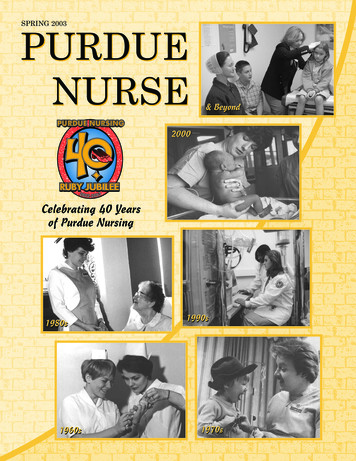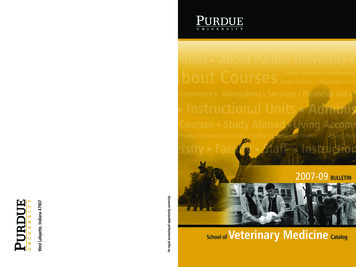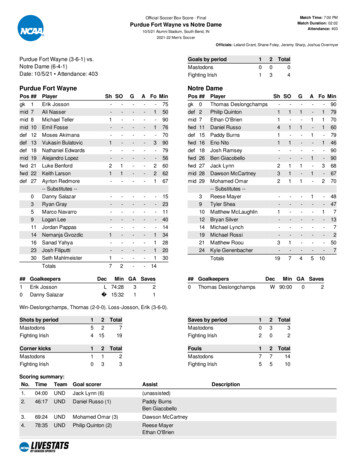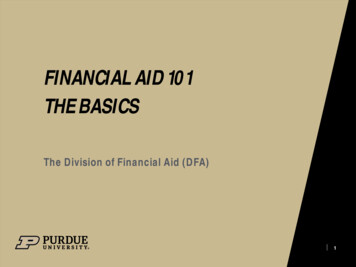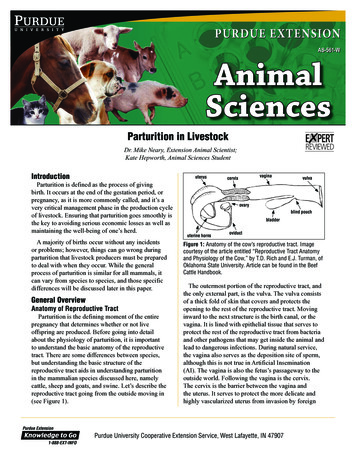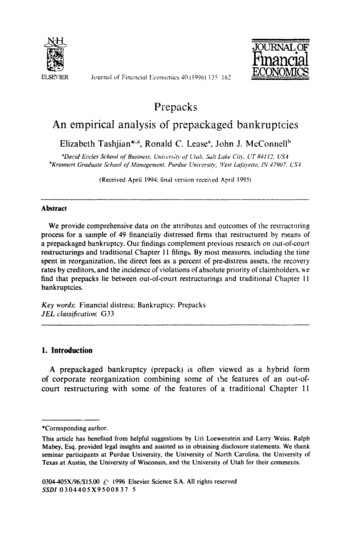
Transcription
Prepacks(Received April 1934: final version received April 1995)AbstractWe provide comprehensive data on the attributes and outcomes of the restructuringprocess for a sample of 49 financialiy distressed firms that restructured by means ofa prepackaged bankruptcy. Our findings complement previous research on out-of-courtrestructurings and traditional Chapter 11 filings. By most measures.including the timespent in reorganization, the direct fees as a percent of predistress assets. the recoveryrates by creditors. and the incidence of violations of absolute priority of claimholders. wefind that prepacks lie between out-of-court restructurings and traditional Chapter 11bankruptcies.Key UYW S:Financial distress: Bankruplcy: PrepacksJEL classification: G?31. IntroductionA prepackaged bankruptcy (prepack) is often viewed as a hybrid formof corporate reorganization combinin, D some of Ihe features of an out-ofcourt restructuring with some of the features of a traditional Chapter 11*Corresponding aurhor.This article has benefited from helpful suggestions by Uri Loewenstein and Larry Weiss. RalphMabey, Esq. provided legal insights and assisted us in obtaining disclosure statements. We thankseminar participants at Purdue University, the University of North Carolina, the University ofTexas at Austin, the University of Wisconsin, and the University of Utah for their comments.0?04-405X/96/S15.00 Q 1996 Elsevier Science S.A. All rights reservedSSDI 0304405x95008375
Frcpacks are a recent, albeit growing, mechanism far restructuring financiallydistret;sed lirms. C‘ryslai Oil, with assets of 342 million, filed a pnpack in J986and is customarily identified as the first major firm to do so.’ Our search ofvarious data bases identifies the next prepack as occurring in 1988, with assets ofS48 million, and two more in 1989 with combined assets of 1.7 bilIion. Duringthe first six monrhs of 1993 alone (which encompasses the end of our sampleperiod), 12 prepacks were tiled by firms with combined assets exceeding 5.5billion. According to New Generation Research, Jnc., a research fiml whichfollows cornpanics in bankruptcy, default. or financial distress, 22 of the 41ybalblir: fifes biih assets cxcccding SJOOmil!iol! that filed for Chapter 1 I in 1993tiled a prepack.Investigations of alternative procedures for reorganizing financially distressedfirms are motivated, at least in part, by concerns that an inefficient bankruptcyreorganization procedure can lead to the dissipation of corporate resources orto the inefficient allocation of capital both before and after the firms becomefinancially distressed 3 The most efficient reorganization procedure is the onethat creates (or preserves) the greatest value net of all costs. Unfortunately,efficiency cannot be observed directly. However, a number of indirect measuresof efficiency, such as the length of time required to reorganize, the direct feesassociated with the reorganization, the degree to which absolute priority isviolated, and recovery rates by creditors, are observable.Eberhart, Moore, and Roenfeidt (1990), Franks and Torous (1989, 1994),Gilson. John, and Lang ( 1990). Gilson ( 1990), and Weiss (I 990) present comprehensive evidence on the attributes and outcomes of the restructuring process forsamples of financially distressed firms that restructured by means of out-of-courtreorganizations and traditiona’l Chapter 11 bankruptcy procedures. This studyis designed to complement previous research by providing similar comprehensive‘See for example, McConnell and Servaes (1991). Chatterjee, Dhillon, and Ramirez (1993). andAltman (1993).‘Lawyers with whom we have spoken believe that prepacks may have been used by smaller firmsprior to 1986.jAnalyses of the efficiency of the Chapter 1 I reorganization process and of the implications ofChapter 11 for the allocation of corporate assets have been undertaken by Bebchuk (1995),Berkovitch and Israel (1991), Bradley and Rosenzweig (1992), Brown (1989), Easterbrook (1990),Gertncr and Scharfstein (1991), Mooradian (1994). and Wruck (1990), among others.
data on prepasks. Oa; mm measures consIdered. prepacks tic: bctwecrz cut-ofcourt restruc’urings a:ad traditional Chapter 11 reorganizations. kxxdingly.ilis tempting to conclude that a prepack is a mare cEcient mecl kxn forresolving financial distress than a traditional Chapter I i reorganization, but lessefiicient than an out-of-court restructuring. Unfortunately. because the firms inour sample have chosen to reorganize by means of a prepack (presumablybecaklse that represents the most efficient form of reorganization for the firm),that conclusion is unwarranted. Thus. our study, like those that precede it, isunable to resolve the question of whether one form of reorganization is moreefficient than another. Nevertheless, the evidence we present can contribute toa more informed discussion.The following section describes certain features of out-of-court restructurings,traditional Chapter 1 “r reorganizations. and prepackaged bankruptcy proceedings. Section 3 identifies the sources used to assemble our sample and providessome descriptive statistics for the firms in the sample. Section 4 presents data onthe frequency with which the first and subsequent prepackaged plans of reorganization were confirmed, the time spent in bankruptcy, the time spent negotiating with creditors prior to filing a prepack. direct fees incurred in the prepack,payof% to creditors, the degree to which absolute priority is violated. and theallocation of post-bankruptcy stock ownership. Section 4 also presents an eventstudy of stock returns around the initial restructuring announcements, thebankruptcy filing dates, and the dates the restructurings are completed. Section5 considers related issues and Section 6 concludes.2. The prepackaged bankruptcy procedureAn out-of-court restructuring typically attempts to reduce the debt burden ofthe financially distressed firm through a voluntary exchange of debt securities,a tender offer for publicly traded debt, or a voluntary restatement of the terms ofprivately held debt such as bank or insurance company loans. These transactions do not require court approval for impiementation. Because these restructurings are voluntary, creditors are not required to participate in thereorganization. Creditors who do not participate retain their original c!aimsagainst the firm. The voluntary nature of out-of-court restructurings does notmean that debtors are without means to coerce creditors into participating inthe reorganization. One form of coercion is the implied threat of a potentiallylengthy and costly traditional Chapter 11 filing if the out-of-court reorganization fails.With a traditional Chapter 11, either the debtor or, less commonly, a creditorof a financially distressed firms files a bankruptcy petition. The debtor thenreceives an ‘automatic stay’ and has the exclusive right to propose a plan ofreorganization within 120 days following the filing date. The debtor need not
For voting purposes, CL tnholdcrs arc grouped in:to ciasse based 011the typeofciaim and the treatment of t.hc claim wxdcr the plan. C’on!irmalinn of lhc placlrequires approval by two-t! irds in arnottr t arld more than one-haIf in numberby each class of claimholder. Unless the courl deterwines that disclosure isinadcquatc or that proper voting procedures were not followed, the vote isbinding OR all participants. ff the plan is not supported by an adequate fractionof claimholders. the court can “cram down’ the plan on dissenting participants.In a Chapter 1 I, all claimholders must exchange their old securities in accordance with the terms of the plan.The primary procedural difference between a prepack and a traditionalChapter 11 is that with a prepack the bankruptcy petition and the plan ofreorganization are filed concurrently. The vote on the prepack may take placeeither before or after the plan is filed. We term the former as ‘pre-voted’ and thelatter as ‘post-voted’ prepacks. As nearly as we can detemline, post-votedprepacks have aiways been permitled. However, the Bankruptcy Reform Act of1978 made specific provision for pre-voted prepacks. Prior to the 1978 Act,bankruptcy law required that any vote on a bankruptcy reorganization takeplace under the auspices of the court. The 1978 Act specifically allowed fora vote to be taken prior to the Chapter 11 filing. As with any other bankruptcyreorganization, confirmation of the plan requires approval by two-thirds inamount and more than 50% in number by each class of claimholder. Ina pre-voted prepack, the outcome of the vote is filed along with the bankruptcypetition and the plan of reorganization and, unless the court determines thatinadequate disclosure was made or that the voting was improperly conducts:?.the vote is binding on all claimholders. The primary procedural differencebetween pre-voted and post-voted prepacks is that with post-voted prepacks,the vote is conducted under the auspices of the Bankruptcy Court after the firmenters Chapter 11.’Thus, prepacks are similar to traditIona Chapter 11 filings in that thereorganization occurs under the auspices of the court and all claimholders mustparticipate in any exchange of securities. They are similar to out-of-courtrestructurings in that the creditors and the debtor have the opportunity to agreeto the terms of the restructuring outside of court. It is these similarities that giverise to the notion of the prepack as a hybrid form of reorganization. In the data4A second procedural difference is that securities issued as part of a pre-voted prepack are subject toSEC registration requirements, while securities issued in a post-voted prepack are not.
3. Sample selectionTo identify our satnple of prepacks, we conduct a key word search on‘prepack’, ‘prepackaged bankruptcy’, and ‘prearranged bankruptcy’ for theperiod January 1980 through June 1993. We use four data sources: the LexisConews File, the National Newspaper ides, the National Magtrrine Idex, andthe Bankruptcy DataSource. The Levis Conews File includes newswire coverageof press releases by firms, credit rating agencies, securities exchanges, andgovernmental agencies. The Badmrptcy Dntdource is produced by New Generation Research, Inc. (NGR). This search identified 84 firms as candidates forour prepack sample. Four of these firms restructured out of court and seven fileda traditional Chapter 11 prior to June 30, 1993. For an additional 13, we foundno indication that the firm had reorganized outside of court or filed a Chapter11 before June 30, 1993. Thus, we identified 60 firms that filed prepacks duringour sample period. Of these 60, we delete 11 because we are unable to obtain theplans of reorganization containing data required for our analyses. Of our fnaisample of 49 prepacks, one firm (the aforementioned Crystal Oil Company) filedo four in 1990.13 in 1991,17 in 1992, andin 1986, two firms filed prepacks in 198,,12 in the first six months of 1993.We do not require that the firms have publicly traded stock or bonds to enterthe sample. However, of the 49 firms in the sample, 44 had at least one publiclytraded security and 23 had publicly traded common stock. The largest firm inthe sample, Southland Corp., had total assets of 3.4 billion, but did not havepublicly traded common stock. The smallest firm, ARIX Corp., had assets of 9.7 million and did have publicly traded common stock. The mean and medianbook value of total assets for the firms in the sample at the end of the fiscal yearprior to the Chapter 11 filing are 570 million and 313 million, respectively.Thus, the relative frequency of firms with privately held stock in our sample isnot so much attributable to the size of the firms, but to the fact that 22 of thefirms underwent a leveraged buyout (LBO) within the seven-year period prior tofiling the prepack. Our sample of 49 firms includes 32 firms that filed pre-votedprepacks and 17 that filed post-voted prepacks. On average, firms that filedpre-voted prepacks are larger than those that filed post-voted prepacks; themean book value of the assets of the two groups are 642 million and 5428million, with medians of 335 million and S167 million, respectively. Appendix A
4. Ihsa analysis snd rcsulltsOne preliminary measure of whether the prepackaged bankruptcy process istikeiy to represent an eficient mechanism for reorganizing financially distressedfirms is whether firms that file F:‘epacks successfully reorganize and emerge fromChapter Il. ‘4 second preliminary measure is whether the first plan of reorganization filed with the Chapter II petition is confirmed by the court. In oursample, all 49 firms eventually reorganized and emerged from Chapter 11. In 38cases, the initial plan of reorganization was confirmed, in nine cases a secondplan was confirmed, in one case a third plan was confirmed, and in the final case,a fourth plan was confirmed.As might be expected, the initial plan was confirmed in a higher percentage ofpre-voted than post-voted prepacks. In 30 of the 32 pre-voted prepacks, theinitial plan was confirmed by the court. In the other two cases (Southland Corp.which filed in 1990 and Sunshine Metals which filed in 1992) sufficient voteswere cast in favor of the firsi plan to achieve confirmation, but the court ruledthat the voting procedure was improper and disallowed the vote. In both cases,before a re-vote was taken on the initial plan, the debtor and creditors renegotiated the plan of reorganization and these slightly modified plans wereconfirmed.Of the 17 post-voted prepacks, the first plan was confirmed in eight anda second or subsequent plan was confirmed in nine cases. As with pre-votedprepacks, the modifications to the initial plans were modest. In two of the ninecases, the only change to the original plan was the ‘minor modification’ ofa bana credit agreement; there were no changes to the principal amounts of theloans. In six of the remaining seven cases, at least one class of nonbank creditorsreceived additional securities or cash, or received debt securities with improvedterms. In the final case, the firm paid the fee of the financial advisor to thenoteholders’ committee. A detailed description of the changes to the initial plansof reorganization is contained in Appendix B.In sum, in a substantial fraction of prepacks, the initial plan of reorganizationfiled with the bankruptcy petition is confirmed. In thosecases in which the initialplans are not confirmed, the modifications to the initial plan are modest. Basedon our preliminary analysis, it is likely that prepacks lead to a reduction intime spent in court relative to a traditional Chapter 11 and to a reduction inthe associated expenses. It is to an examination of these statistics that weturn next.
To compile infoma ion 811Ihe length of time rcyttirsa.l for firins to rcorp;tnizeby mcz ns of a prepack. jv,e scar& lhe Lexis Concws File. the BUltk tf iC’ \DnliLSout’c’c. the WC!f! S!t.t%!l .I:iUY?lL?l !?ldC.Y. LITId Ihe NUSi(?I1fiI!VL l .Sgl! IW1P.Yhr each firm to identify its Chapter ! 1 Ming date and the bankruptcy confirm: ‘lion date. For each firm. we the!2 search these data sources beginning iive yearsprior to the filing date up through the filing date to identiry an initial indicationof a restructuring attempt. Because some firms successfully restructure and thenbecome financially distressed again, we use the first reported attempt at restructuring prior to the prepack :iling, but after any pre\:ious!y completed out-ofcourt reorganization, as the starting date of the restructuring process tilat leadsto the prepack. For 43 firms, we identify at least one attempt to restructure priorto filing a prepack. For the remGning six firms, we assume that the restructuringbegins on the date of the first default on a liability prior to the prepack filingdate.’ This procedure follows Giison. John, and Lang (1990) as a way ofidentifying the beginning of the restructuring attempt.Table I provides summary statistics on the time betweel? the date of theannouncement of the initial restructuring attempt and the filing date of theprepack, the total time in bankruptcy (measured as the number of monthsbetween the filing date and the confirmation date), and the total time inrestructuring (measured as the number of months between the initial restructuring attempt and the confirmation date). As shown in panel A, debtors spent anaverage of 18.3 months negotiating with creditors prior to filing a prepack andmore time was devoted to negotiating pre-voted than post-voted prepacks(means 20.0 months and 14.9 months, respectively). Additionally. as shown inpanel B, pre-voted prepacks averaged less time in Chapter 11 than did postvoted prepacks (1.9 months versus 6.0 months). Apparently, frms that undergoa pre-voted prepxk substitute time negotiating out of court for time spent inChapter 11 relative to firms that undergo a po?t-voted prepack. Indeed, asreported in , .mel C, even though pre-voted prepacks spent less time in Chapter11 than did post-voted prepscks, from start to finish of the entire reorganizationprocess, the total tinte of 21.9 months required by pre-voted prepacks wasslightly greater than the total of 20.9 months required on average for post-voted--- The two most common types of initial restructuring announcements are that the firm is negotiatingwith creditors to restructure the debt (18 cases) and that the firm has renegotiated a covenant ina debt contract (8 cases).At some time prior to filing the prepack. 46 ofthe Cnns defaulted on at leastone liability. By far, the vast majority of the defaults (32 cases) are failure to maks payment ofa liability. It is likely, however. that many of these defaults were preceded by technical defaults thatare not recorded by our data sources. Of the three firms that had not defaulted, one had negotiatedFxbearance agreements with creditors, and two were in imminent danger of default.
Ptinr! c. ?‘inz !jrfanit&k/AI! prcpacksPre-voted prepacksPost-voted prepacksOut-of-courtrestructurings(G&on et al.)TraditionalChapter 1 Is(Gilson ct al.). .- .-. -.-r sf?w?rrrirryrlmlc .8 r xwfr'r7f10 r.r.so ztlion&rwssf /inonc-id(in .749.149331715.41 1 .I)I 072.0801x.5. . . . .- . -. --Not rrportcd89---prepacks. Based on a Wilcoxon rank sum rest. the time spent in out-of-courtnegotiations is marginally significantly grdd;er for post-voted prepacks (z-statistic 1.68). The time spent in Chapter 11 is significantly shorter for pre-votedprcpacks (z-staristic - 4.49), and the total time in restructuring is indistinguishable between the two types of prepacks (z-statistic 0.65).For comparison purposes, Table 1 also gives summary statistics for the timerequired to reorganize out of court and by means of a traditional Chapter 11 asreported by Gilson et al. (1990) and Weiss (1990). Four conclusions follow fromthese comparisons: (1) the length of time spent negotiating prior to filing forbankruptcy is substantially longer for prepacks than for traditional Chapter11 filings (panel A); (2) the length of time spent in court is substantially
less fer prep&s than for Craditional Chapter 1 I reorganizations (panel B):(3) apparently. firms that Sk prepacks substirutc time IlefQti2tiilgoul of cou;tfor time spent in Chapter I i reorganiza ians. However the substitutian is t:otone-for-one. as the total time required tc conrpletc a prepack is sonmvhat closerto. but siiI1 dramatically less than. the time required to complete a traditionalChapter 11 reorganization (panel C); and (4) the total time required !CJ compkiea prepack lies near the midpoint between the length of time required to completean out-of-court restructuring and a traditional Chapter I1 reorgsniza.tion(panel C).We now consider the direct fees associated with resfrLlct:\ring by means ofa prepack. For 39 of the 49 firms in our sample, we are able to obtain data on thedirect costs associated with the financial restructuring from disclosure statements or from the lo-KS or IO-Qs that foliowed the firm’s emergence fromChapter 11. Our definition of direct fees, which includes court costs andprofessional fees, corresponds as closely as possible to Weiss’s (1990)’ The bulkof the fees go to financial advisors. Other elements of the direct restructuringcosts are professional fees paid to lawyers and accountants, and the relativeiymodest expenses associated with mailing and printing the disclosure statementsand ballots. Frequently, the debtor bears the legal and accounting fees incurredby the creditors’ committees.In our sample, the total direct costs of restructuring range from 112,000 IO 55,000,000 with a mean of 7,050,000. As shown in panel A of Table 2. costsas a fraction of the book value of assets range from 0.33% to 12.74%. withan average of 1.85%. where assets are measured 2s of the fiscal year-end prior tothe Chapter 11 filing. As a fraction of assets, the fees paid in prepacks liebetween the average of 2.8% reported by Weiss (1990) for traditional Chapter 11reorganizations and the 0.65% reported by Gilson et al. (1990) for outof-court restructurings. Also, as shown in panel A, the average direct costs asa fraction of assets are modestly lower for pre-voted prepacks (1.65%) than forpost-voted prepacks (2.31%). Based on the Wilcoxon rank sum test, the difference between pre- and post-voted prepacks is not statistically significant(s-statistic 0.40). These data indicate that the direct costs of reorganizing byprepacks generally, as well as by both pre-voted and post-voted prepacks,lie between those of out-of-court restructurings and traditional Chapter 11reorganiziltions.“We thank Larry Weiss for discussing his method for coilecting fee data with us. Weiss’s data comedirectly from court records and, therefore. are presumably more accurate than are ours.
Examination of payoffs 10 :Iaimholders is another way to evaluate alternativemechanisms fol i-estructuring financially distressed firms. Payoffs to claimholders are a concern for at leasr three (interrelated) reasons. The first has to dowith the distribution of .bvvezIthamong claimhoIders, the secJind with whetherabsolute priority is upheld among claimholders, and the third with whethercontrol of voting rights (and, therefore, conirof of the km) is retained by ‘old’shareholders or is transferred to creditors. Each of these concerns focuses or1Table 2Direct costs of restructuring, percentage recover3 rates for creditors and preferred stockholders. andpercentage dollar deviations from absolute priority for 49 prepacks o\‘cr the period October 1986through June 1992Panel A. Direct restnrcturing fees as a percentage of fhe hook aiue q/‘ossets for 39 of 49 prepackrSampleMeanMed.Min.Max.All prepacksPre-votezl prepacksPost-voted prepacksTraditional Chapter 11s(Weiss)Out-of-court restructurings(Gilson et 3.6512.742.82.50.9No. offirms-. ---7.0392712310.013.40180.650.32. . . . . . . . . . . . . . . . . . . . . . . . . . . . . . . . . . . . . . . . . . . . . . . . . . . . . . . . . . . . . . . . . . . . . . . . . . . . . . . . . . . . . . . . . . . . . . . . . . . . . . . . . . . . . . . . . . . . . . . . .Our definition of direct fees corresponds as closely as possible to Weiss (1990) and includes courtcosts and prGfessiona1fees. An estimate of the feespaid by each firm is obtained from the disclosurestatements or from the 10-K or 10-Q statement following the firm’s emergence from Chapter 1 I.Direct assetsare taken from the financial statements at the fiscal year-end preceding the Chapter 11filing. Ten prepacks are excluded in this panel becausewe are unable to obtain estimates of the fees.Pancf B. Average percentage recorevprepackrsrates jtir creditors and preferred shareholders for 41 of 49Type of claim or security (number of firms with one or more classes ofclaimholders in that category in tirefirmAll t-votedprepacks(15)95.xill)19.175.1(26)69.2(15)
Table 2 (cor.:inued)-- ----- -Sample-.--.- - . .-.--- .-. - -. -.-. . . .-Type of claim or security (number of firms wilt! one :r Xorc clasps ofclaimholdc-s in ?hat category ill parentheses)-- - -- - t-of-courtrestructurings(Franks andNo1 reportedx0.1Torou;. 1994)(451TraditionalChapter 1 Isso 9(Franks andNot repc;tcdTorous. 1934)( 3 -/). . . . . . . . . . . . ,. . .,.,.,.The percentage recovery rate !Jr a class of claimholders is the payoffto the class dih,ided by the faceamount oi claims for that class. The face value of the claims for each class of clair.lhoiders is tzkenfrom the firm’s plan of reorganization. To determine the payoff to a class of claimhofdcrs. we urn theamount paid in cash, the amount paid in new debt securities (at face value!. the 31mo:nt pa2 inpreferred stock (at face value), and the amount paid in common stock (at estimated r(iai ket value).The amount of cash, the face amount of debt and preferred stock. and the numr r : i shares ofcommon stock are taken from tLr: disclosure statement. In 30 cases, the closing price: Of commonstock on the first day for which pr,czs arc available following the firm’s emergence from bsnkrop!cqis used to estimate the value cf :ommor. stock. In an additional eight cases where common stockprices are c?availa?le, \\e use an estirrate of the fair market value of common stock from thedisclosure statemen,. Eight prepacks are omitted from this panel. In thcx firms. at CZSIone class ofcreditors or preferred shareholders reccived equity .p r ::I: z’? -1. c.ould not obtain an esrimatedmarket value.*In OUTaample, rtcovery rates exceedin : iW% arise when creditors receive equity which. ex psi,trades at a suticielitly high price that tt- total value of cash and securities received IS greater thanrhe value of the o;rginal claim. . - - -. ---- -.--. . ---. -. --- . -.----. . .-. -.Pans/ C. Areroge prrcen age rlollm dericc ons fkm rthso/u!r ptiori( by, catqpyvr!l‘cl(linrho?(f , , j,qof 49 prepacksType of claim br secur ty (nrlmbcr of firms with at least one classorcla mholdcrs intha? category rn pare orsstockstockclaimsclaici Sample--I- - I.42440.09%i.71%09”- 0.B1%05”All prepacksi38)(38)! i 3)(331(3%(38)0.472.59- 0.91- 40.200.09- 0.570Post-voted0prepacks(141(10)(3)(14)114)(14). . . . . . . . . . . . . . . . . . .The average percentage dollar deviation is the dollar deviation from absolute priority by a categoryof claimholders divided by the total value ieceived by all claimholders for a firm. The product of theaverage percentage deviation and the number of firms with claimholders in a particular categorysummed across all classesofclaimholders is zero. Eleven prepacks for which we couid not obtain accsrimated market value of equity arc omitted from this panel.-- ---.
a different aspect of the way in which the bankrupqprocess influences theallocation of capital.The distribution (or redistribution) of wealth is of interest because of theimplications frsr the pricing of financial claims (e.g., Brennan and Schwartz, WLE). The enforcement of absolute priority has implications for the reliabilityof COti2t.;iiS. if absolute priority is violatcd , tbc contradud agrcerrkents represented by financial claims become unreliable. To the extent that financialcontract:; are designed to assure the efficient allocation of capital, for exa.mple byminimizing monitoring costs, abrogation of financial contracts by the Bankruptcy Court increases the cost of raising capital (e.g., Jensen, 1989, 1991). Thedegree to which control is transferred from shareholders YOcreditors also hasimplications for corporate investment policy. If the bankruptcy process impedesthe transfer of control, corporate managers may be led to ‘over-’ or ‘underinvest’ (e.g., Zender, 1991). To address these issues for prepacks, we examine therecovery rates of creditors and preferred stockholders, the frequency with whichabsolute priority is violated, the percentage dollar deviations from absolutepriority, and the allocation of share cwnership that results from the reorganization.d. 3. I. RecoveryratesThe Bankruptcy Reform Act of 1978 groups claimholders into six categories:unclassified claims, priority cla.ims, secured claims, unsecured claims, preferredstockholders, and common stockholders.8 Because common shareholders donot have a dollar claim against the firm, we cannot calculate their recovery rate(i.e., the fraction of claims paid). To determine the recovery rate for the otherclasses of claimholders, we divide the payoff to the class by the face value ofclaims for that class. The face value of the claims is taken from the firm’s plan ofreorganization. Ideally, in determining the value of payoffs, we would employthe market values of securities distributed plus cash. Because the market valuesof securities distributed are not available in all cases, we use a combination ofbook and market values. To determine the payoff to a class of claimholders, wesum the amount paid in cash, the amount paid in new debt securities (at facevalue), the amount paid in preferred stock (at face value), and the amount paid in‘The abrogation of absolute priority
4A second procedural difference is that securities issued as part of a pre-voted prepack are subject to SEC registration requirements, while securities issued in a post-voted prepack are not. 3. Sample selection To identify our satnple of prepacks, we conduct a key word search on ' prepack' , ' prepackaged bankruptcy' , and .
